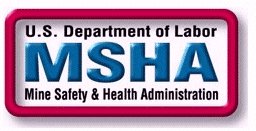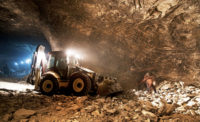 An investigation by the Mine Safety and Health Administration (MSHA) found that enforcement efforts at the Upper Big Branch Mine (UBB) were "compromised" prior to the deadly 2010 explosion there, due to a failure to follow established policy on the part of agency personnel.
An investigation by the Mine Safety and Health Administration (MSHA) found that enforcement efforts at the Upper Big Branch Mine (UBB) were "compromised" prior to the deadly 2010 explosion there, due to a failure to follow established policy on the part of agency personnel.
"While there was no evidence linking the actions of MSHA employees to this tragedy, we found instances where enforcement efforts at UBB were compromised because MSHA and District 4 did not follow established agency policies and procedures," said internal review team leader George Fesak.
The April 5 blast killed 29 miners at UBB. An MSHA report released last December said Massey Energy, then-owner of UBB, violated widely recognized safety standards and failed to prevent or correct numerous hazards that ultimately caused the catastrophic explosion by using advance notice of inspections and intimidation of miners to hide violations from federal inspectors. Three independent reports corroborated MSHA's conclusions.
A report by the internal review team comprised of MSHA employees outside the district where the accident occurred, was released yesterday. The investigators were charged with evaluating agency actions relative to the explosion and making recommendations to improve the agency's performance going forward.
The team not only focused on MSHA enforcement and plan approval activities during the 18 months preceding the explosion, it also evaluated the effectiveness of MSHA standards, regulations, policies and procedures in addressing the hazards that caused or contributed to the disaster.
Joseph A. Main, assistant secretary of labor for mine safety and health, said review was based on interviews with nearly 90 current and former MSHA employees and examined more than 12,500 pages of documents.
The internal review team identified a number of shortcomings in the inspection and plan approval processes:
Due to inspectors' lack of MSHA experience, insufficient training, inadequate supervisory and managerial oversight, and deficiencies in the directives system, which disseminates written policies and procedures, District 4 personnel did not comply with all policies and procedures applicable to MSHA inspections, investigations and mine plan reviews.
• Inspectors did not consistently identify deficiencies in the mine operator's program for cleaning up accumulations of loose coal, coal dust and float coal dust.
• Inspectors did not use the operator examination books records effectively when determining the operator's negligence in allowing identified hazards to continue unabated.
• Inspectors did not identify the extent of noncompliance with rock dust standards along belt conveyors.
• Inspectors did not identify significant deficiencies in the operator's ventilation and roof control plans.
• District 4 personnel did not intervene as Massey manipulated MSHA procedures to avoid complying with reduced standards for respirable coal mine dust and allowed the operator to significantly delay corrective action to reduce miners' exposures to unhealthy respirable dust concentrations after overexposures were identified.
The internal review team identified factors that led to these shortcomings:
• Lack of resources: Budgetary constraints prior to 2006 resulted in significant reductions in the inspection workforce and, despite district efforts to re-establish staffing levels, by the time of the explosion, the inspection and supervisory staff had not fully regained the level of experience it had lost.
• Inspector experience: A newly-hired trainee needs approximately two years to complete classroom and on-the-job training to become a journeyman inspector. When new inspectors were hired after 2006, there were not enough experienced inspectors to mentor them or oversee their on-the-job training. Agency experience among lead UBB inspectors during the review period ranged from 13 to 52 months.
• Management turnover: Between June 2003 and July 2004, four different MSHA personnel were temporarily assigned to the district manager position in District 4.
• Supervisory and managerial oversight: Supervisors did not adequately review UBB inspection reports, identify significant deficiencies or recognize that some portions of the mine had not been inspected. The turnover of supervisors in the Mt. Hope field office, including untrained acting supervisors, contributed to the inadequate review of inspection reports.
"MSHA is responsible for its actions and will address each of the problems the team has specifically identified," said Main. "We take the deficiencies and recommendations outlined in this internal review extremely seriously. In fact, shortly after the tragedy at UBB, we began aggressively implementing a number of corrective actions, some of which directly address the internal review team's findings."
The MSHA said corrective actions put in place after April 2010 include:
• An emergency temporary standard, which became a final rule in June 2011, that increased the minimum combustible content of mine dust to at least 80 percent throughout a coal mine.
• A strengthened potential pattern of violations program to hold mine operators more accountable for safety and health conditions.
• Proposed rules that would revise the agency's existing regulation for pattern of violations, address the continuing risk of coal miners' exposure to respirable coal mine dust and require improved examination of work areas by underground coal mine operators.
• Impact inspections that target mines with a history of noncompliance.
• Program information bulletins on compliance with ventilation regulations, illegality of advance notification, the right of miners to make hazardous condition complaints and legal protections against discrimination.
• The creation of District 12 to provide additional resources in conjunction with District 4 in southern West Virginia.
• Mandatory and refresher training for field office supervisors and inspectors.
Since the tragedy, one former UBB security director was convicted of lying to federal investigators and ordering the destruction of evidence. Another former employee was sentenced to jail time after he was convicted of faking a mine foreman's license and lying to federal investigators. And on Feb. 22, 2012, a UBB mine superintendent was charged in a criminal information for conspiracy to defraud the United States by engaging in a conspiracy to give advance notification of mine inspections, falsify examination record books and alter the mine's ventilation system before federal inspectors were able to inspect underground.



